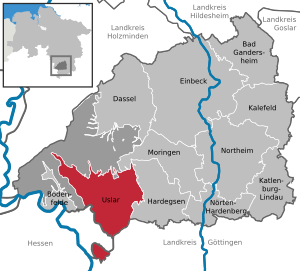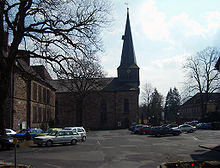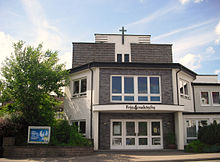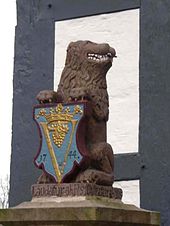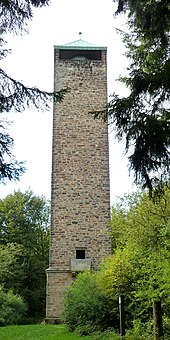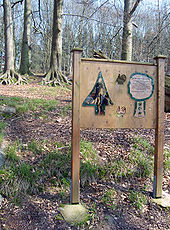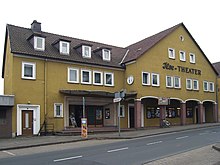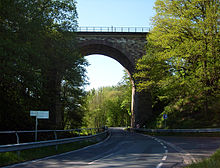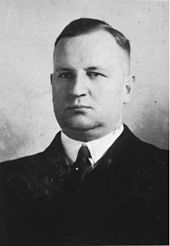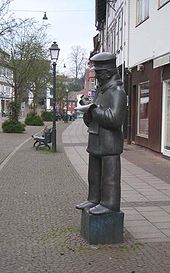Uslar
| coat of arms | Germany map | |
|---|---|---|

|
Coordinates: 51 ° 40 ′ N , 9 ° 38 ′ E |
|
| Basic data | ||
| State : | Lower Saxony | |
| County : | Northeim | |
| Height : | 178 m above sea level NHN | |
| Area : | 113.54 km 2 | |
| Residents: | 14,115 (Dec. 31, 2019) | |
| Population density : | 124 inhabitants per km 2 | |
| Postal code : | 37170 | |
| Primaries : | 05571, 05573, 05506, 05574 | |
| License plate : | NOM, EIN, GAN | |
| Community key : | 03 1 55 012 | |
| LOCODE : | DE USA | |
| City structure: | 19 districts | |
City administration address : |
Graftstrasse 7 37170 Uslar |
|
| Website : | ||
| Mayor : | Torsten Bauer ( CDU ) | |
| Location of the city of Uslar in the Northeim district | ||
Uslar is a small German town and a medium-sized center on the southwestern edge of the Solling in the Northeim district in Lower Saxony . The state-approved resort has around 14,000 inhabitants.
Origin of name
With regard to the etymology of the place name, it is assumed that the band ceramists, named after the characteristic decorations on their ceramic vessels, settled in the Uslar area in the early Stone Age . As far as we know today, rivers and streams had the ending “-ar” or “-er”, whereby “a” may stand for water. Details are not known to this day. The name “Üssel” for the Italsbach, which supposedly means “cold water” (still today, seniors speak of the Üsselbeke in Low German) was derived from the endings. In the course of time the meaning of "-ar" or "-ari" changed into "(storage or pasture) place by the water".
Earlier spellings included Husleri, Huslere, Uslere, Usseler, Usler, Uslir, Üsler and Uslaria. In the meantime Uslar was called Freudenthal for a short time.
Old names: 1006–1007 Huslere, 1141 Ernestus de Vslare, 1142–1153 Eluericus de Uslere, 1189 Eluericus de Uslere, before 1199 Huslere, 1202 Hermannus de Uslere, 1205–1216 Hildebrandus de Uslaria
“-Lar” means “pasture”, “forest”; "Us-" is probably derived from "es-", "wasal", "ooze", "waso", "wase" and means "damp", "wet", "rain", "lawn", "clod of earth" , "Pit", "Moisture", "Mud" or "Moist Ground".
Uslar can be interpreted as "forest, forest in a damp, swampy location". The location of Uslar in an area that is flown around and through by Ahle, Rehbach, Martinsbach and Mühlengraben supports this interpretation.
Uslar used to be nicknamed the “City of Ilsemöbel” (see economic history ) and, like many neighboring towns, claims to be the “gateway to Solling”.
geography
geology
The core city Uslar is located in the in the red sandstone vault of southern Solling recessed sediment trap large and 8.28 square kilometers, woody nature space Uslarer pool (Nr .: 370.2; main unit # 370: Solling, main unit group # 37.:. Weser Tether mountains ) in Central German mountainous country.
The basin landscape around the city center is very fertile thanks to the loess soils and has a hilly, very rural character with many deciduous and coniferous forest areas and streams.
Some of the watercourses in and around Uslar are the Schwülme , the Ahle , the Martinsbach, the Katzbach, the Mühlen- and Hüttengraben and the Rehbach (Ahle) .
From the west to the north to the east, Uslar is surrounded by the forest area of the Solling. In the southeast lies the Bramwald and in the southwest the Reinhardswald . Spruce and beech dominate the forests.
Geographical location
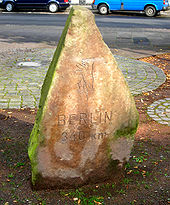
Uslar is located in the southern Weser Uplands, in the southwestern part of the Northeim district in southern Lower Saxony in the former administrative district of Braunschweig.
Larger cities around Uslar are the regional center of Göttingen in the south-east (34 kilometers by road, about 26 kilometers as the crow flies), Kassel in the south, Holzminden and Höxter in the north-west. Uslar borders the Solling in the north as part of the Solling-Vogler Nature Park , the second largest contiguous forest area in the low mountain range of Lower Saxony. The border triangle of Lower Saxony / Hesse / North Rhine-Westphalia on the extreme northwestern outskirts of Bad Karlshafen is about 25 kilometers to the west and the upper reaches of the Weser River in the neighboring municipality of Bodenfelde is also about nine kilometers to the west.
It is about 36 kilometers by road to the district town of Northeim in the northeast (about 26 kilometers as the crow flies), about 120 kilometers to the state capital Hanover in the north and about 350 kilometers to the federal capital Berlin in the northeast.
Uslar functions as a medium-sized center in the west of the Northeim district . In terms of area and population, Uslar is the third largest community in the Northeim district.
Of the 113.4 square kilometers, 13.11 are settlements and 32.81 are natural areas . 67.48 square kilometers are free (as of 1997). In 1999 there were 7,238 apartments for the 16,385 inhabitants.
climate
In terms of bioclimatism , the Uslar area is characterized by a stressful and transitional climate .
Neighboring communities
Adjacent or neighboring communities are clockwise, the cities Moringen and Hardegsen (all district Northeim) which stains Adelebsen and with only 500 meters boundary line (at the enclave Fürstenhagen, Location: 51 ° 33 '11.8 " N , 9 ° 39 2.8 ″ O ) the city of Hann. Münden (both district of Göttingen ), the community of Wesertal ( district of Kassel ) and the community-free area of Solling, which is directly subordinate to the district of Northeim . As a result, Uslar borders indirectly on Bodenfelde, the city of Dassel (both districts of Northeim), the city of Bad Karlshafen (district of Kassel), the city of Beverungen (district of Höxter, district of Würgassen ), the municipality of Boffzen (districts of Lauenförde and Derental ), the city Holzminden (district of Neuhaus im Solling ) and the municipality of Stadtoldendorf (all of the district of Holzminden ).
Although one could assume that there are also direct borders to the city of Einbeck (district of Northeim) or to the community of Niemetal of the Samtgemeinde Dransfeld (district of Göttingen), these do not exist.
City structure
The city of Uslar is made up of the following 19 districts:
| Surname | Population (December 31, 2015) |
prefix |
|---|---|---|
|
|
139 | 05571 |
|
|
589 | 05571 |
|
|
485 | 05571 |
|
|
484 | 05573 |
|
|
327 | 05571 |
|
|
491 | 05571 |
|
|
345 | 05574 |
|
|
283 | 05573 |
|
|
239 | 05571 |
|
|
289 | 05506 |
|
|
425 | 05573 |
|
|
1003 | 05571 |
|
|
852 | 05571 |
|
|
589 | 05571 |
|
|
5530 | 05571 |
|
|
244 | 05571 |
|
|
380 | 05571 |
|
|
1231 | 05573 |
|
|
566 | 05571 |
The southern village of Fürstenhagen, which belongs to Uslar, is a specialty. About lossen of it is enclosed by the Hessian district of Kassel and about ¼ of the Lower Saxony district of Göttingen. Fürstenhagen is therefore an exclave of the Northeim district and the city of Uslar. The village can only be regularly reached via the Hessian village of Heisebeck . In addition, some forest paths that are closed to public traffic lead from the district of Göttingen to Fürstenhagen.
The core city is not officially divided into districts . However, locals differentiate between "Auschnippe", "Bella Clava", "Eichhagen", "Ilsesiedlung", "Industrial area", "City center", "Children's village", "Kleines Feld", "Kupferhammer", "Unterhütte" and "Oberhütte", "Postberg", "Rotenberg", "Schwarze Erde", "Wiesenstrasse" and "Ziegenbusch". The names mostly result from the respective local conditions or from street names and are common names in Uslar and in the surrounding villages.
Also to be mentioned are the "Rittergut Reitliehausen" (in the west of the city center), "Donnershagen" (to Eschershausen), "Haje" (to Delliehausen), "Grimmerfeld" (Delliehausen), the "Knobben", the estate "Steimke" (to Vienna), "Meinte" (eastern part of Eschershausen), "Langental" (to Dinkelhausen), "Warneckenfeld" (to Vienna), and "Steinborn" (to Schönhagen) as more or less demarcated settlements.
The “Forstsiedlung Grimmerfeld” north of Delliehausen still existed in the last century. The settlements "Wangensen" (near Wiensen) and "Schmachtshagen" (near Schönhagen) went under much earlier.
history
Early and Middle Ages
The Uslar area was first settled in the Neolithic Age through early arable farming .
Uslar existed under the name "Husleri" as early as the 9th century. The name is derived from "Yssellär", which means "camp on the cold water". Local founder was probably a strain of the chat . Uslar was first mentioned in writing around 1006/1007 as “Huslere” in the Corveyer Traditions No. 499 as part of a donation of 30 acres of land from Luthardus, a presumably aristocratic landlord .
In the 13th century, when Uslar already belonged to the Duchy of Saxony and was in the border area between Engern and Ostfalen , various feudal lords (e.g. the Counts of Northeim and the Counts of Dassel ) took turns in ruling Uslar. Between 1129 and 1135 two ministerials of Siegfried IV von Boyneburg , Hildebrandus and Alvericus , named themselves after the place Huslere . Then a (water) castle is mentioned, after which the castle men there, the Knights of Uslar, called themselves, not a princely , but probably a noble family.
1263 Uslar were of Duke Albrecht I of Brunswick , the city rights awarded. The Lords of Uslar were ousted by him in 1269 through the appointment of city councils , whereby they exchanged their lands in Uslar for those in today's same and moved to the hilltop castles of new and old equals . In 1262 Duke Albrecht set the knights Hermann III. and Ernst IV von Uslar, bailiff von Corvey , as castle men at his castle Gleichen ; From this line then emerged the family of Barons von Uslar-Gleichen , which still exists today . There is also a possibly tribal, later ennobled Goslar council family von Uslar . Other middle-class families later named themselves after the city because of their origins. The family name still exists in the area around Göttingen, throughout Germany and also in the Spanish-speaking part of South America.
The castle, which was built there later and probably at the beginning of the 14th century, was very important for the Guelphs advancing on the Weser and it was also where people lived and hunted. For this castle in 1428 Otto Cocles (the one-eyed man), who also held court here at great expense and later chose Uslar as his retirement home (1476), built a prince's chapel with a fortified tower , from which today's St. John's Church emerged (A Christian pastor was first mentioned in Uslar in 1277). The church tower was certainly the associated defense tower of the castle.
After Saxony was broken up, Uslar belonged to the Duchy of Braunschweig-Lüneburg , more precisely to its associated Principality of Göttingen and Principality of Calenberg . Uslar was affected by the plague between 1485 and 1490 as well as 1585 . From 1624 to 1642 dysentery , typhus , leaf and smallpox epidemics were also rampant .
Modern times

Between 1559 and 1565, Duke Erich II of Braunschweig -Göttingen had the Freudenthal Castle in Uslar rebuilt in the Weser Renaissance style by Dutch stonemasons under the direction of Elias Godefroy . For this purpose, the residents of this place were relocated to a "Neustadt" in front of the east gate in 1561 in order to create a castle freedom for a better view from the castle , which explains the name of today's "Neustädter Platz". The castle burned down after a lightning strike in 1612 and was no longer rebuilt. The walls of the basement level are still in place in the palace park southwest of the old town . The castle was replaced by the princely administrative building, which in 1855 became the district office of the Uslar district .
As a result of the castle fire, further large fires in 1625 and 1641 and as a result of the Thirty Years War , Uslar lost its importance. The city was raided several times by Tilly's troops during the war . In 1654 Uslar already had a city wall with a moat , as evidenced by the Merian engraving (see picture). A city wall has been documented since 1423.
At the end of the 18th century Uslar then belonged to the Electorate of Hanover (still ruled by Guelphs), more precisely to the Principality of Göttingen, as the successor to the Principality of Calenberg. During the Seven Years' War Uslar was again badly shaken, this time by French troops. As a result of the French Revolution , Uslar soon came as part of this principality to the department of Leine of the Kingdom of Westphalia , a French vassal state (temporarily ruled by Napoleon ). Uslar was the capital of the canton of Uslar at this time . After the Congress of Vienna Uslar belonged to the newly formed Kingdom of Hanover , which was again ruled by Welfs. In 1819, around a third of today's city center (74 houses) fell victim to a major fire that left 115 families with 451 people homeless. From 1866, Uslar belonged to the newly formed Prussian province of Hanover due to the lost sovereignty of Hanover , which ended the Guelph rule.
20th century
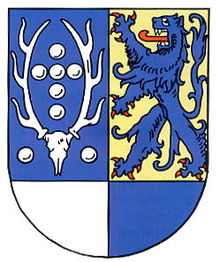
From April 1, 1885 to October 1, 1932, the district of Uslar existed , whose district town was Uslar. It had almost 349 km² and comprised the present-day communities Uslar, Bodenfelde and Adelebsen, which is now part of the Göttingen district, as well as the present-day Holzminden districts of Neuhaus im Solling and Silberborn and Lauenförde in the Holzminden district . At the beginning of the 20th century, around 18,500 people lived in the district. The district of Uslar was incorporated into the district of Northeim on October 1, 1932, with Northeim's administrative seat .
In the First World War were 80 soldiers from Uslar. During the November Revolution of 1918, the city was controlled by workers 'and soldiers' councils for a few weeks . Women's suffrage was introduced in 1919 and the city council was democratically elected for the first time in the Weimar Republic . In 1923 there was hunger riots during the inflation crisis , in which the city issued emergency banknotes .
After street fights between the National Socialists and the labor movement, from 1933 onwards, when the NSDAP came to power, as everywhere in Germany, Jews (17 of whom died here by 1945) and communists were persecuted. Uslar was part of the NSDAP - Gaus Süd-Hannover-Braunschweig . The Ilse settlement was founded in 1938 as a housing estate for workers in the furniture industry. In the Second World War , Uslar suffered 165 deaths, but was largely spared from war damage. Although a Bavarian SS unit with five Tiger tanks as the rearguard of the German army faced the US invasion in Uslar's west from April 6th to 9th, it was able to defeat it on April 9th despite eight fallen in its own ranks Do not prevent Reitliehausen. A short time later, on the orders of the American local commandant, the Albert Schweitzer Hospital was founded (the hospital finally found a home in 1952 in the former house of the "Reinald von Dassel" barracks of the Reich Labor Service Department II / 185 at the St. Johannis Church but closed at the end of March 2013). In July, Uslar was handed over to the British administration. After the Second World War, the population of Uslar increased by more than half as a result of refugees and displaced persons, from 3706 in 1945 to 6207 in 1946. Since 1946 Uslar has also been in the then newly formed state of Lower Saxony. Today's Uslar community was formed on March 1, 1974.
Since the decline of the furniture industry in the second half of the 20th century, Uslar has struggled with structural change . Since then, the unemployment rate in the town has been high, which may also explain the problems in the 1980s and 1990s with right-wing radicalism - especially in connection with the accommodation of civil war refugees from the former Yugoslavia in the 1990s (Uslar was regularly featured in the report of the Lower Saxony Protection of the Constitution mentioned in this regard).
On January 31, 2013 the youth hostel, which belonged to the DJH regional association Hanover, was given up. The German Youth Hostel Association was originally represented in Uslar since 1923. On May 11, 1930, it moved to a new building on the Kupferhammer and was shut down in 1983. The move and the inauguration of a new building followed on October 25, 1985. In 1995 there were over 15,000 overnight stays. In 2015 the hostel was reopened in private hands.
useful information
- At the end of the 19th century / beginning of the 20th century, there was a war memorial in the Graftplatz car park (now in a modified form in the Protestant cemetery). The municipality was then the "new school" (the "old school" was located near the present-day local history museum ).
- The house at the junction of Lange Straße and Kurz Straße was the imperial post office at the beginning of the 20th century .
- The savings bank and the agricultural winter school founded in 1907 were still located in the building above the former post office on Bahnhofstrasse in the middle of the 20th century.
- Until the 1950s, Mühlenstraße had an avenue-like tree planting, like the lower Postberg at the beginning of the 20th century.
- Neustädter Platz (formerly: "Neuer Platz") was a park with an open watercourse of the Martinsbach at the beginning of the 20th century.
Religions
Traditionally, the population is predominantly Protestant - Lutheran denomination (see church district Leine-Solling ). The oldest surviving Protestant church is the St. Johannis Church in Uslar town center. Its foundation stone was laid on May 20, 1428. The St. Martini Church in the Bollensen district of Uslar dates back to 1883. A previous building that no longer exists and was only a few meters away from the location of the Martini Church had already been built at the time of the Christianization of the Solling. In the districts of Allershausen, Dinkelhausen, Eschershausen, Sohlingen, Vahle, Wiensen and Malliehagen there are Lutheran chapels, the oldest of which is the Vienna Jodoci Chapel, built in the 14th century. The Malliehagen chapel was built at the beginning of the 10th century, but has been in ruins since 1496; Extensive conservation work was carried out on it between 1984 and 1986.
For centuries after the Reformation there was no longer a Roman Catholic parish in Uslar . At the beginning of the 20th century, only 17 Catholics lived in the city. Only after the settlement of refugees who came to the Uslar area from the eastern regions after the Second World War did the situation change. In the late 1940s the number of Catholics grew to 3,000. Their church, consecrated to Konrad von Parzham , is located on the street Zum Kleinen Feld 7. In 1962 the church received four new bronze bells from the Otto bell foundry in Bremen-Hemelingen with the following tone series: f '- g' - a '- c'. A branch congregation meets in the Volpriehausen district of Uslar in the St. Josef Church.
The Evangelical Free Church Community (Baptists) was founded in 1886 as a preaching station for the Baptist community in Einbeck . The community received its autonomy in February 1891. In 1909 it moved into its first community hall, a converted residential building, in the Uslarer Neustadt. A church was built in 1933 on Stiftstrasse. In 1975, 1978 and 1994/95, due to the strong growth of the community, an extensive renovation and expansion of the community center, which bears the name Friedenskirche , was carried out. On June 10, 1971, the Lower Saxony minister of education granted the Evangelical Free Church Community of Uslar the rights of a corporation under public law . A small community-owned cemetery is located on Eschershäuser Straße.
A New Apostolic church congregation also existed in Uslar until 2010 . It was attached to the community in Bodenfelde; the church at Lärchenweg 11 was abandoned and converted into a residential building.
Incorporations
On July 1, 1968, Allershausen was united with Uslar, giving up its village name. The Lower Saxony municipal reform that came into force on March 1, 1974 resulted in the incorporation of the municipalities of Ahlbershausen, Bollensen, Delliehausen, Dinkelhausen, Eschershausen, Fürstenhagen, Gierswalde, Kammerborn, Offensen, Schlarpe, Schönhagen, Schoningen, Sohlingen, Vahle, Verliehausen, Volpriehausen and Wiensen Districts of Uslar, which now gave these places more competencies (e.g. in the form of local councils ) than was the case with Allershausen in 1968. On November 1, 2001, Allershausen became an independent village again as a district of Uslar.
Population development
The population of the city of Uslar and most of its districts has been decreasing steadily for several years:
| time | Residents |
|---|---|
| June 6, 1961 | 19,063 |
| May 27, 1970 | 18,478 |
| December 31, 1987 | 16,021 |
| December 31, 1990 | 16,576 |
| December 31, 1993 | 17,380 |
| December 31, 1998 | 16,441 |
| December 31, 2003 | 16,039 |
| December 31, 2008 | 15,100 |
| December 31, 2009 | 14,876 |
| December 31, 2010 | 14,686 |
| December 31, 2011 | 14,676 |
| December 31, 2012 | 14,518 |
| December 31 2013 | 14,369 |
| December 31, 2014 | 14,318 |
| December 31, 2017 | 14,278 |
| December 31, 2018 | 14,236 |
Even the core city itself has shown a steadily declining population in recent years, despite the long-term designation and development of settlement areas, which are very generous in relation to the area of the town. The population of the core city fell by 674 in 2001 simply because Allershausen regained its independence as an independent district of the city of Uslar.
| time | Inhabitants of the core city (from 1976 figures from the city of Uslar) |
|---|---|
| 1689 | 950 |
| 1815 | 1560 |
| 1864 | 2196 |
| 1905 | 2464 |
| 1939 | 3784 |
| 1945 | 3706 |
| 1946 | 6207 |
| 1950 | 6309 |
| June 6, 1961 | 7121 |
| May 27, 1970 | 7315 |
| December 31, 1976 | 7099 |
| December 31, 1980 | 6823 |
| December 31, 1985 | 6643 |
| December 31, 1990 | 6701 |
| December 31, 1995 | 7162 |
| December 31, 2000 | 6849 |
| December 31, 2005 | 6027 |
| December 31, 2009 | 5660 |
| December 31, 2010 | 5602 |
| December 31, 2011 | 5532 |
| December 31, 2012 | 5486 |
| December 31 2013 | 5412 |
| December 31, 2014 | 5416 |
| December 31, 2015 | 5530 |
In the last ten years since the turn of the millennium, the city's population fell from over 16,000 in December 2000 to less than 15,000 in June 2010. Since Allershausen became independent in 2001, the population of the core city of Uslar has decreased from over 6,100 to less than 5,700 Residents.
politics
City council
The term of the City Council is in accordance with § 47 para. 2 of the NKomVG five years, starting on 1 November of the election year a municipal election and ends on 31 October of the following election year. Until the local election on September 11, 2011 , the city council of Uslar had 32 members in accordance with Section 32 of the Lower Saxony Municipal Code, plus the mayor, who is also an official member of the city council in accordance with Section 31 of the NGO. For the election period from November 1, 2006 to October 31, 2011, there is a special feature: Martina Daske, a full-time mayor, was elected for the first time. As a result, the city council received one more seat than usual for the relevant electoral term and consists of 34 seats. This additional seat will no longer apply from the 2011 local elections. For the 2011 local elections, the Lower Saxony Municipal Constitutional Act (NKomVG), which came into force on November 1, 2011, governs the allocation of seats in Section 46 and has not been changed compared to the NGO. Since the population of the city of Uslar fell below 15,000 as of June 30, 2010, the number of seats in the city council for the electoral period from November 1, 2011 according to the NKomVG is reduced to 31 (30 for the elected members, 1 for the directly elected full-time mayor).
Composition of the city council (the seat of the full-time mayor has to be added from 2006):
| Electoral term | CDU | SPD | FDP | Green | left | UWG | Others |
|---|---|---|---|---|---|---|---|
| Nov 1, 2001 - Oct 31, 2006 | 14 seats | 16 seats | - | - | - | 3 seats | - |
| Nov 1, 2006 - Oct 31, 2011 | 13 seats | 17 seats | - | - | - | 3 seats | - |
| Nov. 1, 2011 - Oct. 31, 2016 | 12 seats | 10 seats | - | 2 seats | 1 seat | 3 seats | 1 seat (pirates), 1 seat (Driehorst) |
| Nov 1, 2016 - Oct 31, 2021 | 11 seats | 12 seats | - | 2 seats | 1 seat | 3 seats | 1 seat (Driehorst) |
Although the Northeim district largely belongs to constituency 52 Goslar-Northeim-Osterode in the federal elections , Uslar belongs to constituency 46 Hameln-Pyrmont-Holzminden .
mayor
List of mayors of the city of Uslar:
| Period | Surname | Political party | designation |
|---|---|---|---|
| 1948-1952 | Karl Siegmund Müller | FDP | honorary mayor |
| 1952-1954 | August guy | Flat share | honorary mayor |
| 1954-1961 | August Schönitz | SPD | honorary mayor |
| 1961-1964 | Karl Spitzer | CDU | honorary mayor |
| 1964-1983 | August Schönitz | SPD | honorary mayor |
| 1983-1991 | Reinhold Leipold | SPD | honorary mayor |
| 1991-2001 | Hermann Weinreis | SPD | honorary mayor |
| 2002-2006 | Stephan Kaiser | CDU | honorary mayor |
| 2006-2007 | Hermann Weinreis | SPD | honorary mayor |
| 2007–2012 | Martina Daske | independent, formerly for SPD | 1st full-time mayor |
| 2012– | Torsten Bauer | CDU |
On September 11, 2011, parallel to the local elections in Lower Saxony, a vote was taken on the initiative of the city council to vote Martina Daske out of office, as cooperation between the city council and the mayor was no longer possible. This sparked a highly controversial discussion across the city both before and after. 43.91 percent of the voters voted for and 56.09 percent against the election. On February 1, 2012, Martina Daske announced her resignation and submitted an "application to retire for special reasons" to the President of the Council in Uslar.
List of local mayors of the core city of Uslar:
| Period | Surname | Political party | designation |
|---|---|---|---|
| ? -2002 | Peter Herbold | SPD | honorary local mayor |
| 2002-2006 | Gerd Lütge | CDU | |
| 2006-2011 | Arno Riedke | SPD | |
| 2011-2013 | Gerd Lütge | CDU | |
| 2013– | Arno Riedke | SPD |
It has been agreed in the local council that Gerd Lütge will step down halfway through the current electoral term and Arno Riedke will take over the office for the rest of the electoral term.
List of town directors in Uslar:
| Period | Surname | Political party |
|---|---|---|
| ? - 1982 | Heinz Arens | |
| 1982-2007 | Herbert mastering | SPD |
household
The city has been heavily indebted for years and austerity measures have also been implemented for years, such as switching off street lights from midnight in 2008, which is highly controversial among the population.
The budget for 2010 approved on March 18, 2010 is the first in the city of Uslar to be managed according to the double-entry principle . This is required by the New Municipal Accounting (NKR) .
Because of the high level of debt, the 2010 budget was not approved by the Northeim district or the Lower Saxony Ministry of the Interior as municipal supervisory authorities. The reason for the refusal of approval is the high debt of the city of Uslar, which was calculated at more than 21 million euros as of December 31, 2010 when the 2010 budget was resolved , 16.6 million euros of which were cash advances , while at the same time maintaining high expenditures for volunteers Services that the city is not obliged to provide. In order to obtain subsequent approval, the city council committed itself to extensive cost-cutting measures in June 2010, which were contractually agreed with the Northeim district. In addition to the obligation to present a balanced budget from 2012 and to generate a surplus in the following years, the reduction of expenses for voluntary services and the creation of a budget security concept are part of this contract. In addition to the budget, the city of Uslar was also approved the cash loans and the prospect of debt relief. The cuts in voluntary benefits from 1.6 million euros to below 500,000 euros are particularly drastic and led, among other things, to the announcement that the indoor pool would be closed (Uslarer Badeland) if no new operator is found.
As a result, citizens joined together to form a citizens' initiative, which subsequently founded a development association in order to maintain the indoor swimming pool beyond May 31, 2011, when the municipal utilities of the city of Uslar closed the indoor swimming pool. As announced, the indoor swimming pool was closed on May 31, 2011. The water park was reopened on November 25, 2012 by the association.
coat of arms
Description (blazon) : The coat of arms of the city of Uslar shows a red tin wall , flanked by two red round towers with blue roofs, in between on a red base - topped with a silver Gothic pointed shield , inside a green Gothic "V" - a red-reinforced and bezungter blue Lion. This lion is the image of the statue " Braunschweiger Löwe " standing in Braunschweig , which Henry the Lion had erected in 1166 as a symbol of his power.
The current coat of arms, approved in 1935, is based closely on the city's oldest known seal from the late 13th century. The city's seal images varied slightly over the centuries; The background of the coat of arms was yellow until 1935, there were crosses on the towers, the base was temporarily a "V" or a city gate and the lion was the Lüneburg lion. In 1952 the coat of arms was changed slightly for the last time.
In 1618 Uslar had a coat of arms, like the lion, who until 1826 stood on a fountain in front of the historic town hall and now stands to the left of the main entrance, holds it with his paw: a crowned “V” in blue and gold. The sandstone statue on the base represents the Brunswick lion.
The city's colors are green and white.
Town twinning
A town partnership exists since March 18, 1999 with Człuchów (Schlochau) in Poland. A partnership with Kerteminde in Denmark that had existed since 1985 was dissolved in 2010 as a result of territorial reform in Denmark.
Culture and sights
The Weser Renaissance Route, the “Frau-Holle Route” of the German Fairy Tale Route and the German Half-timbered Route run through Uslar . The region around Uslar is marketed in the holiday industry as "Uslarer Land". Guests can stay in hotels, pensions and a small holiday village with 18 holiday homes. In total there are more than 200 guest beds in Uslar and its districts. Since the beginning of 2008, a tree house hotel has existed in Schönhagen as a special feature. In Schönhagen and Delliehausen-Haje there are also campsites and in Uslar itself at four different places there are parking spaces for mobile homes and a youth camp. Uslar has its own tourist office in the historic town hall.
Buildings
The landmark of Uslar is the former town hall in the city center, rebuilt in 1476 after a fire, with half-timbering and a copper clock tower roof that was added later. Right next to its main entrance sits a stone carved lion on a stone pedestal, the teeth of which are painted white and which holds a Gothic coat of arms on which a golden “V” (Latin “U”) is depicted on a blue background. A town hall was first mentioned in 1406. In 1476 the eastern half of this two-storey building was built, while the western part was built between 1650 and 1655, which z. B. can be seen on different consoles . The town hall was renovated from September 1998 to November 2006 for 5.6 million euros , whereby the type of renovation is not only highly controversial among the population of Uslar.
- The St. John's Church ( Evangelical-Lutheran ) with the still recognizable Gothic high choir , for which the foundation stone was laid on May 20, 1428 , with a hand-carved, magnificent three-part winged altar and colorful glass paintings from around 1470, which in their value resemble those of Cologne Cathedral , is dedicated to St. John the Baptist . The builder was the Guelph Duke Otto the One-Eyed of Göttingen. Under the west tower is the oldest part that remains from a vaulted basilica from the 13th century. The organ (26 / II) built by the Euler company in 1845 is on the west gallery . Today it is one of the most outstanding instruments in southern Lower Saxony, as its current condition is still very close to the original. The older western part of the church was originally Romanesque . The church was rebuilt from 1841–1845 according to the plans of chief architect Georg Ludwig Friedrich Laves , a son of the city, as a three-bay nave with a hall cross-section on cast-iron pillars with wooden and plastered vaults using the old foundations. As one of 17 in Germany and 77 in Europe, it has a winding church tower. Also worth seeing are the sacrament house with the coronation of Mary next to the altar , the tombstone of the first pastor of Uslar, Jost Bauerfeindt, who died on October 17, 1594, valuable consoles with masks of angels in the chancel, the pulpit from 1844 and the one on the outer wall of the A crucifixion group inserted in a high choir, which probably comes from the old Romanesque church.
In Uslar's city center you will find town houses with magnificent and valuable half-timbered facades, with shops and businesses in the Lange Straße, which is paved with red natural stones; an example is the oldest town house from 1555, today's Hotel Menzhausen (formerly Hotel Bussiliat / Gasthof Wicke), which was first inhabited by the hunter Jacob Fischer.
Farther:
- Brewery and bakery
- Municipal museum of local history, an old saddle yard in the immediate vicinity of St. John's Church and town hall; Restored in 2004
- Sollingturm , built in 1934/35, around 30 meters high stone observation tower on the 444 meters high Strutberg near Sohlingen to the northwest of Uslar
- Lookout tower Harzblick on the 493 meter-high Great Steinberg at Vahle, from which the view to the resin ranges
- Remains of the former city wall in the core town south of St. Johannis Church (with partially preserved city gate on the Amtsweg), on Mauerstraße and on the forest garden; The names Mühlentor and Isertorweg are also related to the city wall.
- Desertification and church ruins Malliehagen north of Dinkelhausen
- Northeim - Uslar station, 1876 on the railway line Ottbergen Royal Westphalian Railway built
gastronomy
Since the invention of the “Peker market” in Uslar, the “Peker food” of the same name has been offered as a Uslar specialty and tourist attraction. The name "Peker" is derived from the Low German name for their original method of preparation: In the villages around Uslar, freshly harvested potatoes used to be cut in half and pressed with the cut surfaces against the hot inside of the baking chambers of the common kitchen stoves. Due to a chemical reaction, the potato halves initially stuck to it (Low German “peken”). They then fell off after the cooking process.
In the autumn in Uslar and the surrounding area, so-called "sausage samples" take place in many restaurants, where samples of various freshly prepared meats and sausages are offered. A hearty Mettwurst with bread is also popular. Both specialties are especially produced in domestic slaughterhouses. Many restaurants also offer traditional “ Bregenwurst meals”.
The Haffner private brewery founded by Friedrich Wilhelm Haffner has also existed there since 1868 and produces beers under the Bergbräu brand.
In the urban area there are various catering establishments such as cafes, pubs, pubs and restaurants with German, Greek, Italian, Chinese-Asian and Caucasian cuisine as well as snack bars and kebab shops.
Outside the city, there was a small restaurant in the "Eichholz" until 2010 in the immediate vicinity of the so-called "Dunie-Eiche". For decades it was a popular destination, especially in summer. In September 2010 it was destroyed by arson.
Museums
There are two museums in Uslar. One in the city center and the other in the Uslar district of Volpriehausen:
music
There has been a lot of musical activity in Uslar for some time. For example, the "Sollinger Herolde", which had since been dissolved, were known far beyond the city limits. It exists:
- Choral societies .
- Trumpet choirs (Eschershausen and Volpriehausen).
- Big band "Solling Swing Orchestra".
- Church music at St. Johannis, with a choir, children's choirs, gospel choir and flute group.
- Local bands were supported by the association “Musik- und Kulturinitiative Musikbus e. V. "until its dissolution. For example, the punk band " 20/20 Vision " (originally "Generation Fuck") , which has since been disbanded, also became known abroad.
- The band "Reminder" as the oldest rock band in the region, which is also very well known in the area.
Natural monuments
- The “ErlebnisWald” project shortly after Schönhagen not far from the main road to Neuhaus im Solling and Holzminden (former - unfinished - external location of the World Exhibition Expo 2000 in Hanover in 2000).
- The "Eichholz", a kind of urban forest in the south of the city center, with some centuries-old deciduous trees (including the so-called "Dunie oak" with a chest height of 7.95 meters). A “tree type path” was created there by the Winnefeld State Forestry Office.
Parks
- Alaris butterfly park with free flying butterflies.
- Parks in the city center. The largest is the castle park, then the forest garden and the water park with the monastery garden.
Regular events
- Christmas Market
- During the Advent season, a door is opened daily on a large Advent calendar hanging on the town hall as part of a large raffle
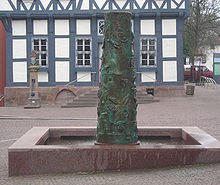
- two weeks before Easter, the Sunday of Lent takes place, every year the so-called "Spenneweih" instead (the Uslarer "Spenneweih" is a more than 660 year old tradition, the medieval two arms foundations from the years 1342 and 1398 returns)
- at Easter the Easter bonfires in the Uslar villages
- At the end of the carnival season there are corresponding celebrations in the village community halls of Vienna and Schoningen
- Raising the maypole on May 1st in many districts
- Every Friday from 8 a.m. to 1 p.m., weekly market (Uslarer Landmarkt) in the former pedestrian zone (Lange Straße).
- City tour every Tuesday from May to October
- Brewery festival at the Haffner private brewery in July (every two years, most recently on July 14, 2012)
- Flight day Uslar (it takes place every three years at Uslar airfield, usually in August or early September)
- In the period after Christmas, various theater performances by amateur actors
- in the villages the tradition of the “New Year's Goat” is usually maintained by the bachelors on New Year's Eve.
- During the summer holidays, the city youth organization offers a varied program of leisure activities for schoolchildren and young people as part of the “Aktion Ferienspaß”
- Since 2009 the so-called “Uslar Old Town Run” has been taking place in the city center
- annual city festival "Pekermarkt" in the city center on the second Sunday in September, various shops are open from 11 a.m. to 6 p.m.
- annual "Street Festival" on a free weekend in September with a stage program and a Sunday shopping.
- Since 2008, the “Night of Culture”, jointly initiated and organized by Uslar citizens, artists and associations, has been taking place in Uslar every year at the beginning of October and the end of September.
- Since 2008 the former association “Musikbus eV” has organized the “Solling Jam” in the “KulturBahnhof Uslar” as part of its “Mixed Emotions” concert series with the support of the Uslar City Youth Care and the City Youth Association. The previous event ("Weser Jam") took place in 2007 in the neighboring community of Bodenfelde with the support of the local youth worker.
Sports
In Uslar there are several sports and tennis courts, sports and multi-purpose halls as well as village community centers, a stadium, a glider flying site, a heated outdoor pool in the Uslar district of Volpriehausen, a swimming pond in Schönhagen on the site of the EXPO project ErlebnisWald and a swimming lake in the district of Delliehausen, Fitness center, bowling alleys, riding stables, cycle and mountain bike trails, hiking trails, in winter, with permafrost, opportunities for ice skating on the ice pond in the direction of Steimke / Schoningen.
The "Uslarer Badeland", a heated 600 square meter indoor pool with an 84 meter long slide and an outdoor swimming pool, was closed from June 1, 2011. The closure was decided in a city council meeting at the end of May 2011 "with a large majority". Thanks to the initiative of a citizens' cooperative founded in the spring of the following year, the water park was reopened on November 24, 2012 by citizens.
Boßeln is a traditional sport in Uslar .
The city's most famous football club is the VfB (Association for Movement Games) Uslar 1911.
theatre
In the 1950s, the “Ilse-Werke”, which dominated Uslar's economic life at the time, built the “Ilse Theater”. Despite the efforts of the last owner, who converted it into a cinema with two halls, the facility was closed in 2008 due to financial problems.
planetarium
On the grounds of Gut Steimke, south of the Eichholz grove, there is a small planetarium built and operated by the Förderkreis Planetarium Göttingen eV. The six-meter-diameter dome, located directly under the roof on the second floor of the concert barn, is equipped with modern technology and offers space for around 30 visitors. The Uslar Planetarium, which opened in May 2015, is the only one in the southern Lower Saxony area to date. The nearest other planetarium in the region is in Kassel.
Others
- In the Uslar district of Allershausen, the former train station building was converted into a cultural center, partly with municipal funds, through the commitment of the “Musikbus eV” association and the youth welfare officer at the time. Since its opening in September 2003, it has contributed to enriching the cultural scene in the rural areas of southern Lower Saxony with regular events. The center is now known far beyond the region. The varied program from the "Kulturbahnhof Uslar" (sponsor is the sponsoring association of the same name) offers many regional, national and international bands and musicians a platform for public appearances. It also includes exhibitions, poetry readings, disco evenings for young people, discussion events, film screenings, concerts, presentations and theater performances.
- Various events of the Art and Literature Circle Uslar.
- The club landscape in Uslar is diverse.
- The former discos “Zum Korken”, “Meeting” (in the building of the former station “ Uslar Stadt ”), “Lipstick” (in the district of Sohlingen, previously “Thirtyfour”) and “Show Inn” in Schoningen (in the building of the former Schoninger dairy ) do not exist anymore.
- Nature trail on the Rothenberg.
economy
The most important industrial companies in Uslar include Ilse Möbelwerke, which are currently in insolvency proceedings, Sollinger Hütte and the Schneider iron foundry. There are also smaller metalworking companies and two suppliers to the automotive industry. The company Demag Cranes operates a production facility in Uslar and is the largest local employer. Most of the companies are located in the west and south-west as well as in the east and north-east of the core city in commercial areas.
There are also initiatives to promote tourism and tourism. Forestry, livestock and agriculture, but also all other branches of the economy (including production, handicrafts, retail and wholesale including various supermarket chains, petrol stations and motor vehicle trades) can be found in Uslar.
Four old people's and senior citizens' homes are located in the Uslar city area: in Uslar, Delliehausen, Volpriehausen and Schlarpe, one of which has an geriatric psychiatric ward. Supervised apartments for the elderly are offered. Care has recently played an increasingly important role in the Uslar economy. This is also reflected in a senior citizen share of over 20 percent. The reason for this is u. A. the quiet location and the landscape.
Processed raw materials are water, sand and wood, as is also reflected in economic history.
There are 570 workplaces, but in this particularly structurally weak region of South Solling, due to years of struggle with structural change (e.g. the decline of the furniture industry), unemployment has been high for years at 15 percent (March 2005; 17.6 percent 2000) high and many Uslarer work v. a. in Göttingen. The below-average job supply is also reflected in the fact that in 2000, measured against the population of approx. 16,000, there were only 3846 employees subject to social insurance, including 240 trainees. The area around Uslar and Bodenfelde is therefore one of a total of three areas in southern Lower Saxony in the “Leader Plus” program of EU funding.
Economic history
Uslar's industrial history goes back to the Middle Ages of the 14th and 15th centuries with the production of crossbows ("Uslarer armoste") for northern Germany. Uslar was a (passive) member of the Hanseatic League from 1426 to 1431 .
In addition to the copper smelter, which has existed since the 16th century (from which the name of the street "Kupferhammer" derives), came the (state) royal iron smelter, which is now the Sollinger ironworks, founded in 1715 .
From the second half of the 17th century until 1918 Uslar was known for the extensive manufacture of clay pipes, which was of great importance for Uslar at the time. A large part was exported to North America, with the faces on the pipe bowls being those of the respective American presidents. In 1769 there were 9 pipe makers and the Meseke company exported more than 4.5 million pieces in 1854. In 1918 this profession died out in Uslar for good.
But cigars were also made in tobacco factories in the 19th century, of which the Zigarrenmacherstrasse in the city center is still remembered by name. A charcoal burner was and is operated in Delliehausen and there was a sample bleaching facility in Sohlingen.
Uslar got into a major crisis due to the decline of the linen trade and clay pipe production as well as an economic downturn in the ironworks in the 19th century.
It should be noted that the industry in the Uslar area was not well connected to the important trade routes in Germany until the Solling-Chaussee was built and later also the Sollingbahn (see traffic). B. the important Poststrasse, which extended the Hellweg, ran north of the Solling. This deficiency could only be remedied with the construction of the Solling Railway.
In 1868 the private brewery Haffner was founded by Friedrich Wilhelm Haffner. First a brewery was built in the city (Auf der Graft). Due to the higher demand and the need to increase capacity, the brewery moved to the location on the outskirts (Rosenstrasse), which is still used today.
In 1883 a sugar factory was founded in Uslar.
From the end of the 19th century until well into the second half of the 20th century, Uslar was world-famous for its furniture industry, which at that time was by far the most important branch of industry there. In addition, there was a boom in Uslar's economy from the 1920s to the 1960s, especially since Uslar was not destroyed in World War II and production could therefore be resumed very quickly. In the 1930s there were 2,000 workers in the furniture industry and in its heyday from 1950 to 1960 even 2,800. In the 1960s, Uslar was at full employment. At that time there were three furniture factories (Ilse, Sollinger Holzwarenfabrik and Neugarten & Eichmann), all of which later merged into the Ilse factories that still exist today.
In the first half of the 20th century until 1932 a stone and potash mine was operated by the Burbach Potash Works in Volpriehausen. The shafts “ Wittekind ” (sunk 1898–1901 up to 558 meters, previously called “Justus I”) in Volpriehausen and “Hildas Glück” (1907–1915 sunk down to 949 meters) near Ertinghausen were finished on September 29, 1945 after the end of the war Explosions of stored explosive devices have been destroyed and flooded and have now been filled. From 1885 to 1952, the mining of (inferior) Young Tertiary lignite from the Pliocene and Miocene near Delliehausen in the "Sollinger Zeche" and "Alsace" pits was interrupted by the consolidated Sollinger lignite works and the Hoch- und Tiefbau AG as well as a paint factory operated. In this respect one can speak of an area in the Uslarer Land.
The furniture industry then went under in the 1970s, so that Uslar has been struggling with structural change since then, but has not yet overcome it. Tourism and elderly care currently play a special role in Uslar's economy.
Infrastructure
Substation to the 110 kV network that has also run through Uslar since 1957, municipal utilities (street lighting since 1874, waterworks since 1898, sewage treatment works and power supply since 1903), police station, volunteer fire brigades and rescue station, doctors (general, ENT, gynecology, surgery, ophthalmologist ) and dentists.
traffic
Street
The federal road 241 from Northeim in the east to Beverungen in the west runs right through the Uslar area. The federal autobahn 7 Hanover-Kassel ( motorway junctions Nörten-Hardenberg ) and the Südharzautobahn (A 38) Göttingen- Leipzig in the east and the A 44 Dortmund- Kassel in the south-west (junction Warburg ) can also be reached, as can the federal highways 3 , 27 , 64 , 80 and 83 . The section of the B 241 in the Uslar area was only well developed in modern times - more precisely from 1828 to 1832 as Solling-Chaussee from Nörten via Hardegsen, Uslar, Schönhagen, Amelith to Lauenförde.
For motorcyclists, Uslar is very popular not least because of the wooded and winding Bollert mountain route of the B 241 in the west (which has been relocated since 2011), which nevertheless also has many long straight lines (there is also a large motorcycle house of a Goldwing importer, which has a well-known and very frequented meeting point for bikers).
Also important for the Uslar area is the road 554 from Uslar via Adelebsen to Göttingen, via which Göttingen can be reached in the easiest way.
The federal road 497 joins the B 241 coming from Neuhaus im Solling in Schönhagen.
All the nearest communities in Uslar can be reached directly by motor vehicle, although some of these roads have only been significantly expanded in modern times (today's Landstrasse 548 Uslar-Dassel 1851, today's Kreisstrasse 449 Uslar-Bodenfelde 1844-1848). The traffic volume in and around Uslar is not high.
train
Uslar is located on the west ramp of the single-track, non-electrified “ Solling Railway ” Ottbergen – Northeim (Han), which opened in 1878 . It is managed as route book route 356 with route number 2975 and is used here every two hours by DB Regio . The route has stops in the Uslar district of Allershausen at kilometer 35.52 and in Volpriehausen at kilometer 42.12 (dismantled stations). The Uslar train station in Allershausen had an alternate and a loading track until 2007 (but is no longer a goods tariff point) and a mechanical signal box. In 2008 the loading track was expanded. The western signal box called "Uslar West Fahrdienstleiter (Uwf)" was built in 1937. The eastern one was demolished in 1996. The signal box has not been in operation since October 2008. The station is remotely monitored by the EStw Göttingen. Furthermore, the route runs over a dam at Allershausen and Bollensen, has a viaduct on the Steimke southeast of the city center and runs between Volpriehausen and Ertinghausen through a 960 meter long tunnel. In the change from the 19th to the 20th century, the Solling Railway was an important route in the German rail network and therefore also important for the economy in the Uslar area.
Furthermore, the Göttingen – Bodenfelde railway line, which is also not electrified, has been used since 1910 . This regional train is listed as route book route 356 under route number 1801. Stops near Uslar are in Offensen (kilometer 24.73), Wahlsburg OT Vernawahlshausen and Bodenfelde. The Verliehausen station (kilometer 28.28) has been closed.
Via Göttingen there is a connection to the long-distance network of DB with the ICE route Hanover – Würzburg. Connection to regional trains via Northeim , Göttingen and Ottbergen , in Ottbergen in particular towards Höxter and Holzminden.
From 1921/1928 to 1989/1990, the Uslar – Schönhagen (Han) line existed with the Uslar Stadt station .
At the beginning of the 1980s, Sollinger Hütte had one of the few VW buses that had been converted for rail transport.
bus
Direct bus connections (line 210) of the Verkehrsverbund Niedersachsen (VSN) by the operator Regionalbus Braunschweig via the stop to the black earth in Göttingen via Adelebsen and 510 to Holzminden via Neuhaus im Solling.
Bus connection via the central bus station in the west of the city center to all districts as well as to Hardegsen (line 212), Bodenfelde, Derental and many districts of Wesertal (in Hesse).
Air traffic
Uslar airfield. The special airfield (ICAO code EDVD) of the Luftsportvereinigung Solling eV is located west of the city center. The airfield is approved for motor planes and gliders up to 2000 kilograms (no scheduled services).
Boat traffic
Via Bodenfelde there is a connection in the Weser passenger boat traffic between Hannoversch Münden and Hameln.
media
There is a regional edition of the Hessische / Niedersächsische Allgemeine (HNA) as well as various commercials (e.g. “Tip aktuell”, “yellow sheet” called and “Oberweserwochenzeitschrift” (OWZ)) that complement the newspaper there. The Göttinger Tageblatt is also read in Uslar. There used to be the weekly “Sollinger Nachrichten” since 1861.
In and around Uslar, analogue or digitally transmitted radio and television programs from Lower Saxony, Hesse, North Rhine-Westphalia, Saxony-Anhalt and Thuringia can be received terrestrially. In some places even radio programs from Bremen and Bavaria. The GSM telephone networks and DAB have many dead spots around Uslar.
The different districts of Uslar are in four different local telephone networks. Most of the participants can be reached under the area code 05571, while the eastern districts have the area code 05573 (local network Uslar-Volpriehausen). Offensen belongs to the local network of Adelebsen and therefore has the area code 05506. Fürstenhagen belongs to the local network of Oberweser and has the area code 05574. The district Vernawahlshausen of the Hessian community Wahlsburg, however, also belongs to the local network of Uslar and has the area code 05571.
In the postal system Uslar has the postal code 37170. Postcodes in Uslar have the postal codes 37162 to 37166 and 37168. The former postal code was until 1993 (W-) 3418 with the delivery districts 1 and 2, whereby some villages had the (unofficial) postal code 3419. Uslar has been regularly served by the postal service since the 18th century.
Public facilities
Administration (with branches of some district authorities such as the vehicle registration office).
education
Kindergartens , four elementary schools (in Uslar, Schoningen, Volpriehausen, Schönhagen), a children's village in the city center , Georg-Laves- Hauptschule , Sollingschule ( Realschule ), Gymnasium Uslar, special school with a focus on learning, adult education center , technical schools for geriatric care and curative education care of Albert-Schweitzer -Family plant.
The local schools are also attended by students from the neighboring communities of Wesertal (Hesse) and Bodenfelde. Students from Uslar also attend the Bodenfelde comprehensive school .
Until 2002 there was also an orientation stage.
Others
- The Uslar police station is also responsible for Bodenfelde. The part of the Weser with the Hessian / Lower Saxon state border in the middle of the river that belongs to the district also belongs to this station for the police across the entire width of the river.
- The adjective and the inhabitants are not called "Uslarer" as is sometimes heard "Uslaraner".
dialect
- A Low German dialect is still spoken by older residents.
Personalities
sons and daughters of the town
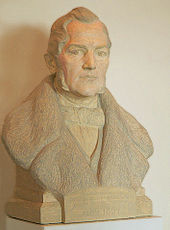
- Georg Ludwig Friedrich Laves (1788–1864), an important architect of Classicism , worked in Hanover from 1814 (among others by him: conversion of the Leineschloss, Herrenhausen library pavilion , mausoleum in Berggarten, Waterloo column , opera house ). The redesign of St. John's Church in Uslar was also undertaken by him, although this was not completed. Furthermore, the beveling of the house corners at the junction of Kurz Strasse / Braustrasse / Mühlenstrasse goes back to him as fire prevention.
- Gustav Herbst (1803–1893), physiologist and university professor
- Richard Greve (1840–1913), Lutheran pastor
- Oskar Zeller (1863–1949), surgeon
- Karl Unselt (1894–1970), writer
- Harry Haffner (1900–1969), National Socialist lawyer. As the successor to Roland Freisler , he was the last president of the People's Court .
- Otto Adam (1909–1943), resistance fighter against the Nazi regime
- "Speaker Bode". His memorial is in the former pedestrian zone in front of the Kreissparkasse and he is depicted on the 50-pfennig note of the earlier Uslar emergency money from 1921. It was a kind of walking communication organ for the citizens of Uslar.
- Martin Just (* 1930), musicologist and university lecturer i. R.
- Rolf Johanning (* 1940), local politician (SPD)
Other personalities connected with Uslar
- Detlef Hörold (1955–2016), freelance entertainer and musician
- Ingo Bartussek (* 1957), animal photographer (best known for his raccoon photos) lives in Allershausen
literature
- Achim Gercke: Uslar. Church, castle and market in their significance for the history of the city. Uslar 1955.
- Andreas Reuschel: Laves and his hometown Uslar . In: Harold Hammer-Schenk, Günther Kokkelink (ed.): From the castle to the train station. Building in Hanover. Exhibition catalog, Hanover 1988, pp. 109–113.
- Andreas Reuschel: Freudenthal Castle in Uslar . In: Yearbook for the district of Holzminden, Volume 5/6, Holzminden 1987/88, pp. 78-88.
Web links
Individual evidence
- ↑ State Office for Statistics Lower Saxony, LSN-Online regional database, Table 12411: Update of the population, as of December 31, 2019 ( help ).
- ↑ Lower Saxony State Parliament, 16th electoral period, printed matter 16/3359: Small question What is the significance of predicates such as “state-approved climatic health resort” especially for heather tourism and the tourism industry in Lower Saxony? (PDF) . Retrieved March 22, 2011.
- ↑ J. Hövermann: The natural space units on sheet 99 Göttingen. Bad Godesberg 1963. Web link: http://geographie.giersbeck.de/karten/099.pdf . Retrieved April 19, 2019.
- ↑ a b c d Population data of Uslar including districts, published by the city of Uslar (as of December 31, 2015). Retrieved on May 29, 2016
- ↑ Jürgen Soenke: Triumph of Mannerism in Stadthagen . In: Otto Bernstorf, Jürgen Soenke (Hrsg.): Dutch art in Stadthagen . Grimme, Bückeburg 1964, p. 35-80, p. 43 .
- ↑ https://www.hna.de/lokales/uslar-solling/uslarer-krankenhaus-ende-maerz-dicht-2253793.html
- ↑ http://www.hna.de/lokales/uslar-solling/uslarer-jugendherberge-schliesst-herbergsverband-verteidigt-voriegen-2726211.html
- ↑ http://www.dtoday.de/startseite/nachrichten_artikel,-Jugendherberge-Uslar-in-Betrieb-_arid,453287.html
- ↑ Homepage of the St. Johannis parish : St. Johannis Uslar , accessed on April 19, 2019
- ↑ Homepage of the village of Bollensen: St. Martini parish ; accessed on April 19, 2019
- ↑ Homepage of the St. Johannis Church: The Evangelical Lutheran churches and chapels in Uslar-Stadt and Uslar-Land ( page no longer available , search in web archives ) Info: The link was automatically marked as defective. Please check the link according to the instructions and then remove this notice. ; accessed on November 26, 2010
- ^ Gerhard Reinhold: Otto bells. Family and company history of the Otto bell foundry dynasty . Self-published, Essen 2019, ISBN 978-3-00-063109-2 , p. 588, pp. 139, 141, 239, 559 .
- ↑ Gerhard Reinhold: Church bells - Christian world cultural heritage, illustrated using the example of the bell founder Otto, Hemelingen / Bremen . Nijmegen / NL 2019, p. 556, pp. 149, 150, 220, 513 , urn : nbn: nl: ui: 22-2066 / 204770 (dissertation at Radboud Universiteit Nijmegen).
- ↑ Homepage of the Diocese of Hildesheim: Catholic parish of St. Konrad von Parzham ( Memento of the original from October 23, 2012 in the Internet Archive ) Info: The archive link was inserted automatically and has not yet been checked. Please check the original and archive link according to the instructions and then remove this notice. ; accessed on November 26, 2010
- ^ Homepage of the Evangelical Free Church Community in Uslar: Review ; accessed on November 26, 2010
- ↑ website of the New Apostolic Church of Central Germany: ; Accessed October 24, 2012
- ↑ City of Uslar: Portrait . Retrieved March 20, 2011.
- ^ City of Uslar: Allershausen . Retrieved March 20, 2011.
- ↑ Official figures of the State Office for Statistics and Communication Technology Lower Saxony
- ↑ a b c d Federal Statistical Office (Hrsg.): Historical municipality register for the Federal Republic of Germany. Name, border and key number changes in municipalities, counties and administrative districts from May 27, 1970 to December 31, 1982 . W. Kohlhammer GmbH, Stuttgart / Mainz 1983, ISBN 3-17-003263-1 , p. 214 .
- ^ Karl Haubner: The city of Göttingen in the railway and industrial age . August Lax, Hildesheim 1964, p. 14.
- ↑ Lower Saxony municipal code . Retrieved March 19, 2011.
- ↑ Frank Schneider: Will the city council save seats? In: Hessische / Niedersächsische Allgemeine , April 21, 2010. Retrieved March 19, 2011.
- ↑ Results of the Uslar city council election on September 9, 2001 (PDF; 19 kB) . Retrieved March 19, 2011.
- ↑ Municipal data processing center in southern Lower Saxony: final result of the city council election of Uslar 2006 . Retrieved March 19, 2011.
- ↑ Municipal data processing center in southern Lower Saxony: final result of the city council election of Uslar 2011 . Retrieved September 17, 2011.
- ↑ Municipal data processing center in southern Lower Saxony: final result of city council election Uslar 2016 . Retrieved September 12, 2016.
- ↑ The Federal Returning Officer: constituency 047 "Hameln-Pyrmont - Holzminden" ( Memento of the original from May 17, 2011 in the Internet Archive ) Info: The archive link was inserted automatically and not yet checked. Please check the original and archive link according to the instructions and then remove this notice. . Retrieved March 19, 2011.
- ↑ Mayor election in Uslar: Torsten Bauer wins . HNA online article from July 22, 2012.
- ↑ KDS: quick message for the deselection of Mayor Daske 2011 on September 11, 2011 City of Uslar . Retrieved September 11, 2011.
- ↑ Uslar mayor Martina Daske throws in the towel . HNA article dated February 3, 2012.
- ^ After the Daske retreat: construction sites for the city and council . HNA article dated February 3, 2012.
- ↑ A half with Lütge . Retrieved July 29, 2012.
- ↑ City of Uslar: 40 years and 1200 weddings . Retrieved March 21, 2011.
- ^ City of Uslar: City director Meistering is retiring . Retrieved March 21, 2011.
- ↑ a b City of Uslar: household data. Retrieved March 21, 2011.
- ^ Frank Schneider: Budget without approval . In: Hessische / Niedersächsische Allgemeine, April 28, 2010. Accessed March 21, 2011.
- ^ Frank Schneider: Timetable for the budget . In: Hessische / Niedersächsische Allgemeine, May 19, 2010. Accessed March 21, 2011.
- ^ Frank Schneider: austerity and rift . In: Hessische / Niedersächsische Allgemeine, June 9, 2010. Accessed March 21, 2011.
- ^ Frank Schneider: Land decrees bitter cure . In: Hessische / Niedersächsische Allgemeine, July 20, 2010. Accessed March 21, 2011.
- ^ Frank Schneider: Deadline for the Badeland . In: Hessische / Niedersächsische Allgemeine, October 8, 2010. Accessed March 21, 2011.
- ^ Frank Schneider: Solidarity for Badeland rescue attempt . In: Hessische / Niedersächsische Allgemeine, February 9, 2011. Accessed March 21, 2011.
- ↑ Uslar: Association wants to save Badeland . In: Hessische / Niedersächsische Allgemeine, April 7, 2011. Accessed April 8, 2011.
- ↑ Citizens' cooperative opens indoor swimming pool . In: Hessische / Niedersächsische Allgemeine, November 23, 2012. Accessed December 8, 2012
- ↑ Main statute of the city of Uslar (PDF) . Retrieved March 22, 2011.
- ^ City of Uslar: Partnerships . Retrieved March 21, 2011.
- ↑ Frank Schneider: Kerteminde terminates the partnership . In: Hessische / Niedersächsische Allgemeine, May 12, 2010. Accessed March 21, 2011.
- ↑ Ev.-luth. Parish office Uslar: Ev.-luth. St. Johanniskirche Uslar. 1971.
- ↑ Gerhard Brothage: Allershausen at Uslar. The village between riding school, railway and city limits. Verlag Jörg Mitzkat, Holzminden 2003, ISBN 3-931656-61-6 , p. 77, p. 84.
- ↑ http://www.hna.de/nachrichten/landkreis-northeim/uslar/feuer-schaenke-naherholungsgebiet-polizei-ermittelt-926391.html
- ↑ Music bus is disbanded. HNA article (October 14, 2013).
- ^ Entry in the directory of monumental oaks . Retrieved January 10, 2017
- ↑ Uslar Old Town Run 2013 ( Memento of the original from July 24, 2014 in the Internet Archive ) Info: The archive link was inserted automatically and has not yet been checked. Please check the original and archive link according to the instructions and then remove this notice. Announcement on a website of the organizer
- ↑ Start-finish-victory on the pavement article of the HNA (Hessische / Niedersächsische Allgemeine) about the Uslar old town run 2012
- ^ City of Uslar - Tourism - Street Festival. Retrieved September 16, 2019 .
- ↑ 1st Night of Culture in Uslar Event information on the City of Uslar website.
- ↑ Neuer Verein rises today an article in the HNA (Hessische Niedersächsische Allgemeine) about the fourth night of culture in Uslar.
- ↑ Hip-Hop-Party in the train station. Online article by the HNA (Hessische / Niedersächsische Allgemeine).
- ↑ Closure of the Uslarer Badeland costs almost one million euros Article from June 1, 2011 in the HNA (Hessische / Niedersächsische Allgemeine).
- ↑ Uslarer Badeland: The cooperative is online article of the HNA (Hessische / Niedersächsische Allgemeine), May 23, 2012.
- ↑ Jubelsprung im Badeland online article by HNA (Hessische / Niedersächsische Allgemeine), November 25, 2012.
- ↑ www.gut-steimke.de Website of the operator of Gut Steimke.
- ^ Opening of the planetarium at Gut Steimke near Uslar . Press release of the Society for the Promotion of the Planetarium in Göttingen from May 4th 2015
- ↑ World of Stars over Uslar. Göttinger Förderkreis opens the region's first planetarium at Gut Steimke . HNA article about the opening of the Uslar Planetarium (May 10, 2015)
- ↑ Kulturbahnhof Uslar event archive on the website operated by the sponsoring association “KulturBahnhof Uslar eV”.
- ↑ Nature trails in the Weserbergland (PDF, accessed on March 15, 2011) ( page no longer available , search in web archives ) Info: The link was automatically marked as defective. Please check the link according to the instructions and then remove this notice.
- ↑ “A hundred years after my death, people are still talking about Redner Bode!” Uslar emergency bank note from 1921 with a picture of “Redner Bode”. Drawn by Karl Klanke, printed by the business books factory Edler & Krische (Hanover).

